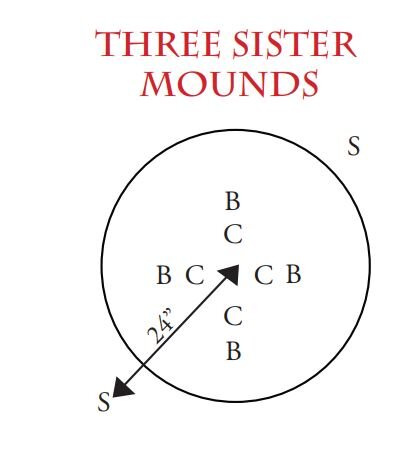Three Sisters Gardening
Example of a three sisters garden (image courtesy of ecoliteracy.org)
At some point this winter I came across the idea of three sisters gardening and made a note in my planner to do some more research before spring. Well spring is here and I’m hopefully just a few weeks away from planting so I dove into some research on the topic hoping it would make my vegetable garden more efficient and productive.
What is the three sisters method?
First, the three sisters are corn, beans, and squash. These crops have been the center of Native American agriculture for centuries. They were considered a gift from the gods and were to be grown, eaten, and celebrated together. The name originated with the Haudenosaunee, also known as the Iroquois, who lived around the Great Lakes region. The name “three sisters” describes their companion planting method, with the plants growing symbiotically to support one another like three sisters. Companion planting has come back around, replacing the modern version of single row crops which lack any biodiversity and do not support pollinator attraction or nutrient building in the soil. This centuries old method fits in with the modern term of regenerative farming, the method of growing crops and managing farms that is helping to rebuild soil and reduce our carbon impact.
What are the benefits?
These three crops work together both in growing and providing nutrient dense food. Locating them together also helps draw in pollinators, giving a boost to the growth of your entire garden. Their growing roles break down as follows:
Corn: the stalks provide living stakes for beans to climb.
Beans: they are nitrogen-fixers, using the rhizobia on their roots to take in nitrogen from the air and convert it to fertilize the soil. They also help to stabilize the corn stalks in heavy winds.
Squash: their large leaves shade the ground, maintaining moisture and preventing weeds.
In the kitchen, they create a complete and balanced died. Corn provides carbohydrates and beans are powerhouses of proteins and amino acids. The squash rounds it out with your daily serving of vitamins and minerals. If you are looking to build up a store for the winter, these crops can all be dried and stored in a root cellar or other cool, well ventilated space.
When do you plant it?
As warm season crops they must be planted after the danger of last frost. A new tool I found while researching this topic is the Frost Dates Calculator from the Old Farmer’s Almanac. To save my Lincoln readers time, April 27th is the last spring frost predication. I also looked up all the last frosts from the last 10 years and there have been plenty of last frosts the week prior as well. But planting next weekend is risky and only buying one extra week for the growing season. Today, its most common to plant the seeds in stages to ensure they work together instead of competing.
Week 1: plant the corn after danger of first frost first so it can grow tall above the other crops
Week 3 or 4: after the corn is about 6 inches tall plant the beans
Week 5: plant the squash seeds
How do you plant?
In the Haudenasaunee planting method, a large mound is created and all three types of seeds are planted together. The elevated mound helps with drainage and keeps water from pooling on the plant roots. Depending on your space constraints you have options on how to plant. Native Seeds has a great handout showing the options for how to plant. For the mound style, the one I plant to try, the steps are:
Create a mound of soil about 1 foot tall by 3 to 4 feet wide with a flat top that is about 10 inches across. Space each mound 4 feet apart.
Plant 4-6 kernels of corn 1 inch deep on the flat part of the mount, 10 inches apart in a circle about 2 feet in diameter.
Plant the beans evenly spaced surrounding the corn stalks.
Plant six squash seeds, evenly spaced (about 18 inches apart), around the perimeter of the mound.
In addition to the mound planting version you can also plant a square field or a separated rectangular version. In the square field corn is planted in at least a 5x5 grid with one row of beans surrounding and squash three feet from the bean row at least three feet apart. In the separated rectangular version the seeds are planted next to one another, but the vegetable types are not mixed, like a small version of a farm with crops separated into sections. Regardless of which method, the goal is to plant all three crops in clusters on low wide mounds rather than in a single, separated manner.
The Farmers Almanac is a great resource for all things plants and does a great job discussing varieties to plant. Basically you want a pole bean, not a bush bean, so it will actually climb the corn. Sweet, dent, or popcorn will all suffice for your corn variety. Finally, the squash should be a small-leafed variety and can be a summer squash (zucchini) or winter squash (Hubbard). All three require a good amount of sun so the location should be somewhere with at least 6 hours of full sun daily.
I am pretty excited to give this method of growing vegetables a try this year and have the perfect space in my front yard to test it out. I was also blessed/cursed with a giant pile of compost hidden behind my garden shed that is going to come in handy when creating the mounds. Just a few more weeks and I’ll be able to get started.








